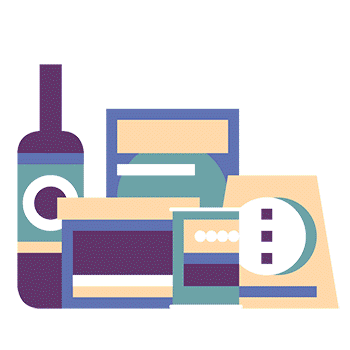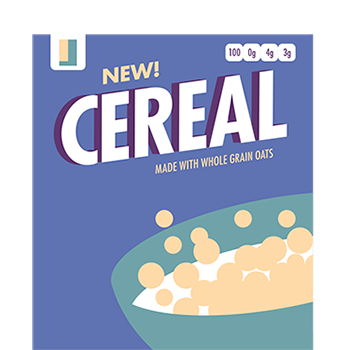
A package is something that encloses something else. A package covers and protects what it is carrying. Packages can hide or reveal contents. Containers inform us of their content by shape, size, advertising or showing what is inside. They also surprise us! They secure elements safely. Packages can be porous (letting air in and out) or completely closed (vacuum sealed). Packages can preserve, and they can nurture. Packages hold surprises- precious ones and everyday objects. Packages can be functional (serve specific purposes) and even multi-purpose (reusable).
It’s easy to overlook package design because we’re focusing on what’s inside! However, in many cases, plenty of thought goes into the container that a product comes in. Everything from a package’s material, shape, and size to its aesthetic appearance are determined by the package’s purpose and the message that it wants to advertise. Many of today’s designers are working to make environmentally-friendly containers that are recyclable or reusable.
Let’s package it!
Activity 1 – Nature's Packaging

Think about packages that carry items in the natural world. What comes to mind? Seeds package inside shells, flowers, and fruits protected by a combination of sun, temperature, and moisture urge them to germinate and grow. Caterpillars spin a cocoon in which to shelter their metamorphosis into a moth or butterfly. Many animals like fish and birds package themselves inside of eggs. Fish eggs are soft membranes while bird eggs are a thin, hard shell that the growing baby bird can crack to emerge. Babies grow in a womb that provides nourishment and shelter for nine months of growth in a mother’s body. Acorns are the packaging of tree seeds. What is a person’s packaging? What is our outside organ? Explore nature’s packaging and ask nature how it creates life-friendly packaging. Sketch three different life-friendly packagings from nature and suggest how they apply to our packaging systems.
Activity 2 – Pick your Favorites

Start by looking for three favorite package designs. These can be anything from a soup can label or a bag of coffee to the box that your headphones come in. Explore local stores for examples of great packaging. Once you have your three favorites, draw or photograph them, while looking closely at their construction, form, protection, and labeling. Write down what you like about each one. What makes it a successful package? Does it represent its product well? Is it well-formed? Is it a successful container? Is it unique? What do you think other package designs could learn from them? Under your drawings or photographs, list the positive and negative attributes of each package.
Be a package critic!
Activity 3 – Package Structure

Before designing the graphics and aesthetics of a package, designers decide on its shape and structure to best serve its function. Packages can be a box, bag, can, or bottle depending on the product itself. Packages keep things insulated, or fresh, or sealed from light or dry; they also help customers carry or transport the goods inside. Designers need to keep in mind the consumer when creating packages. How can they make designs that are appealing and easy to use and convenient to carry and store while securing the contents? Structural packaging design can also help a product stand apart from the competition. Some containers go beyond the simple box to create higher quality experiences. Package diagrams show dielines, or folding lines, that display a deconstructed container in 2D. Find a package that you can unfold, and draw its dielines.
Deconstruct your packages!
Activity 4 – Package Typography

One of the most critical features of package design is the typography or the arrangement of type. The text conveys what a package contains and how much of it. Good typography is appealing and helps to advertise the product it features. The fonts that a designer chooses should be appropriate for the brand and the product. As more and more products enter the market, designers face the challenge of creating a type that is consistent with a brand while standing out on the shelf. Catchy package design has hierarchy in that it calls attention to itself and is large and visible from a distance. The closer you get the more information should become legible. For instance, the name of the product and the brand are usually more visible than the weight or number of its contents. Try your hand at designing typography for a juice carton. Draw three different versions by hand or digitally. Look back at your favorites or find other packagings as inspiration and guides.
Activity 5 – Sustainable Packaging

A very needed growing trend is bringing green design to packages. To combat the enormous waste that humans produce each year, designers are creating packaging that is more earth-friendly. Material choice is a first essential factor in sustainable packaging. Using plant-based biodegradable materials instead of plastics ensures that a discarded package won’t sit in a landfill for centuries. In addition to packages that consist of recyclable materials, many containers make use of recycled products. Minimizing the number of material needs is the best way to eliminate waste. Designers continue to search for new ways to reduce the amount of packaging necessary to secure products. Some new containers biodegrade after use. Consumers are also responsible for selecting and recycling sustainable packaging. Recycling and reusing packings reduce waste. Collect all of the packages your household uses in one week. Sort the waste into categories- bottles, boxes, bags, trays, etc. Take a photo of your waste packages make a chart of which use recycled material and which are landfill.
Surprised?
Activity 6 – Redesign a Package

Now you can put your knowledge of packaging design to the test. Pick an everyday product around your home and design an improved sustainable package for it. Focus on addressing these questions: What can change? What new materials could you use? How can the amount of material be reduced? Keep in mind how you use images and type as you create your design. Draw your package from multiple views to see how it all comes together.
Review
- Hierarchy helps to establish what information is most important in a package.
- When designing a package, graphic design comes before structure.
- What is an example of sustainable packaging?
- Nature's packages include
- What is the most effective way to eliminate waste from packaging?
Explore
- BXP Package Design Magazine
- Design is History: Packaging
- DeZeen 12 Minimalist Package Designs
- Dieline Package Convention
- DieLine Package Design Directory & Website
- Distant Village Packaging
- Forma Structure
- Green Blue
- How to Create a Good Package Design Brief
- Overflow Design
- Packaging & Dielines
- Pitfalls of Packaging Research Infographic
- Redesign of the First Aid Kit
- Sustainable Packaging Coalition GreenBlue
- Tridimage Package Portfolio
- Video Re-Thinking Progress The Circular Economy



















































